高中英语语法主谓一致(50张PPT)
图片预览
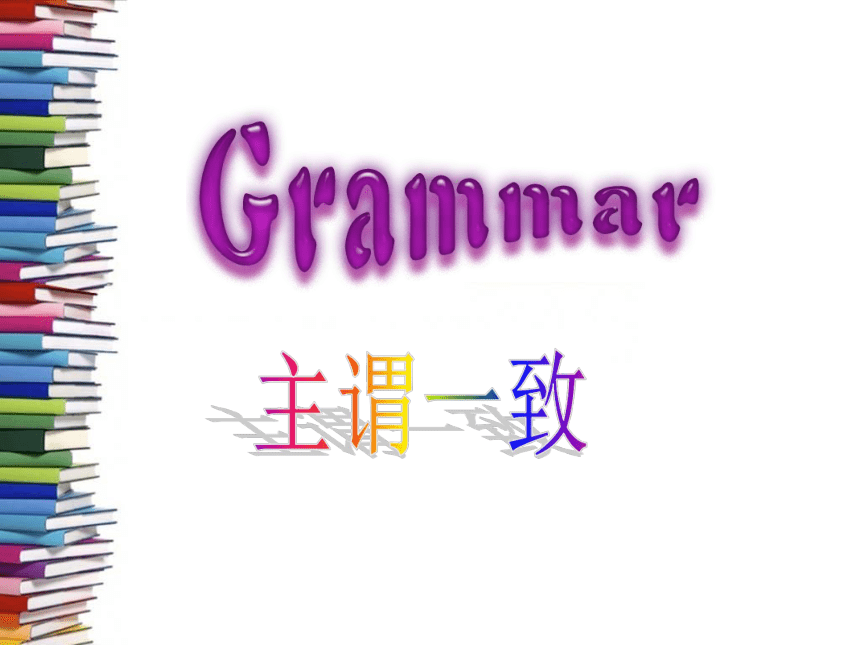

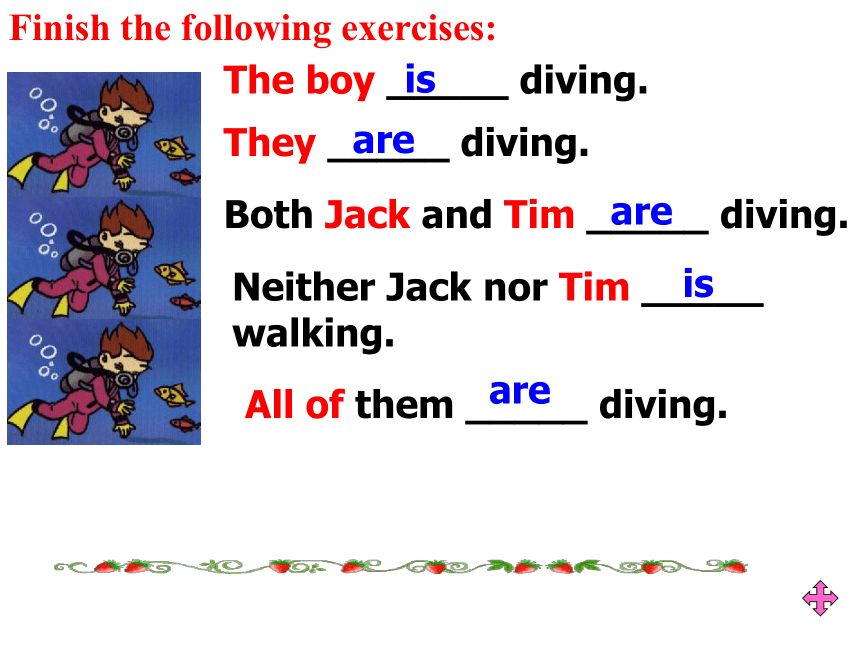
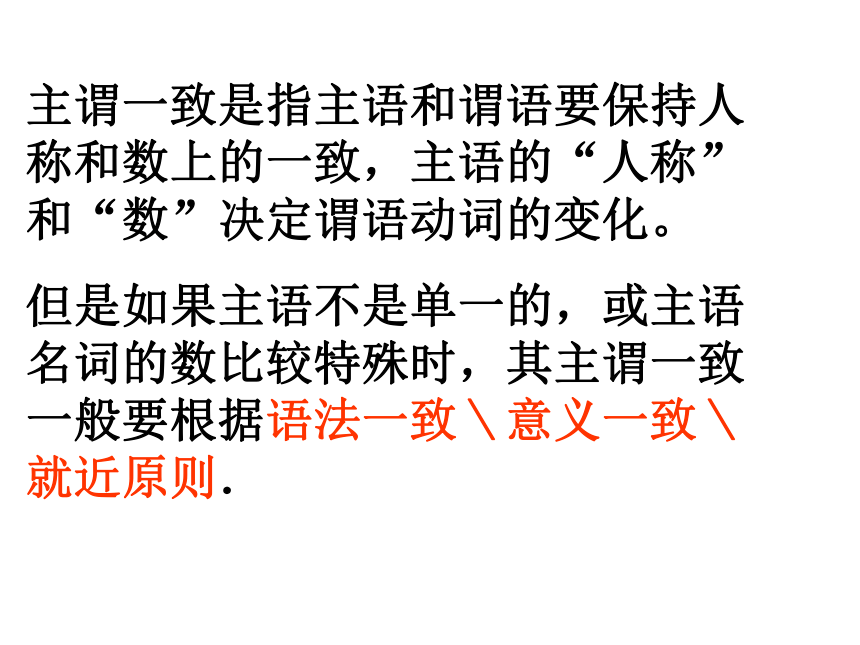
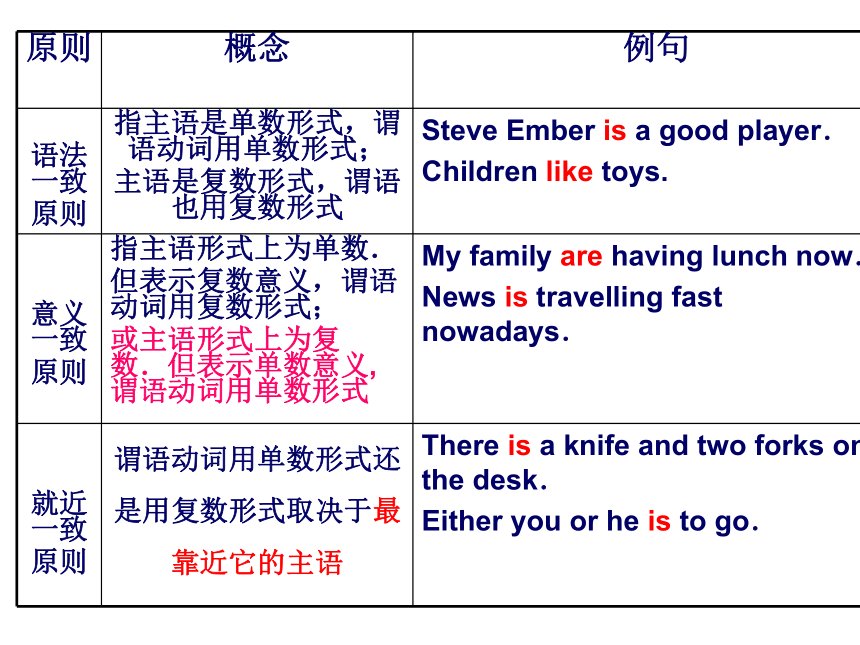
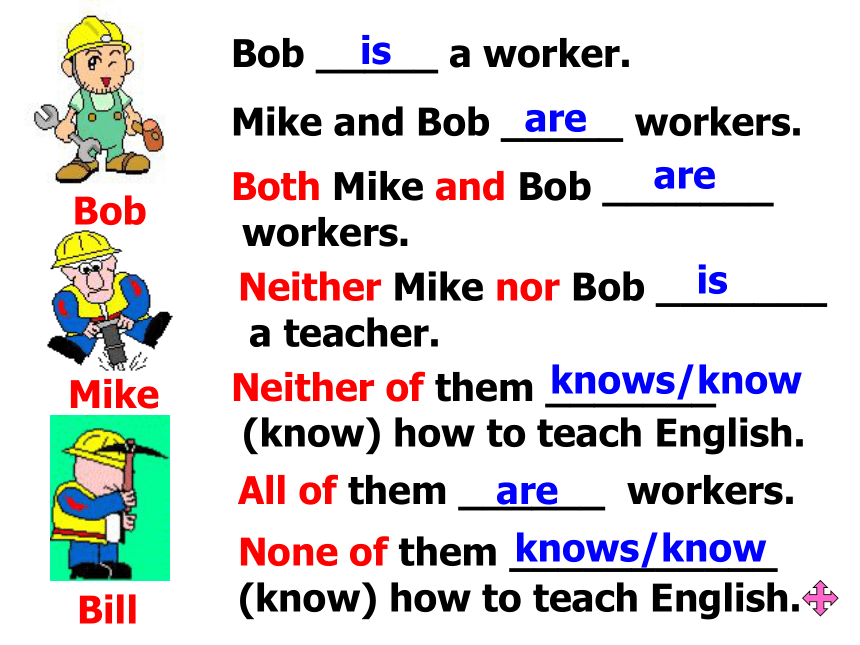
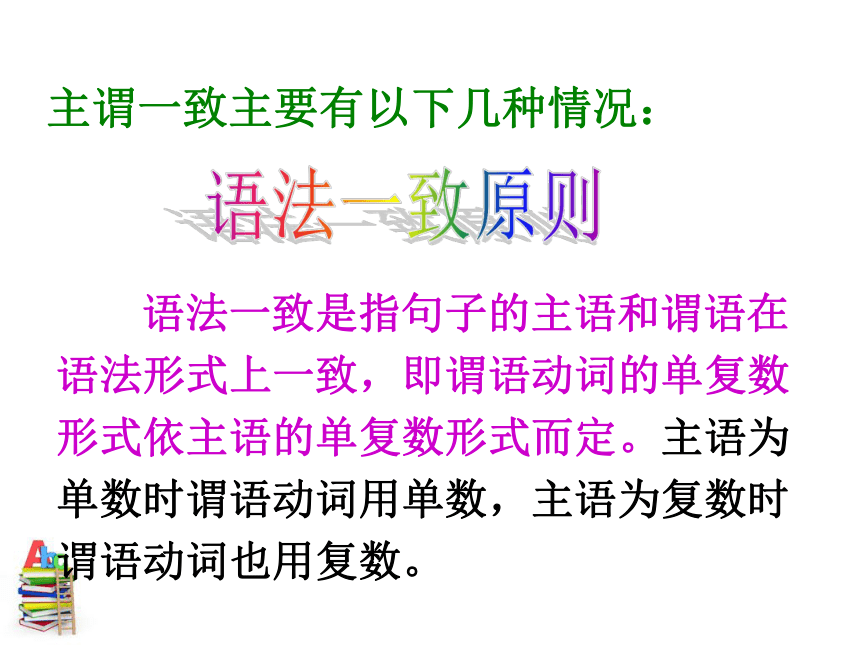
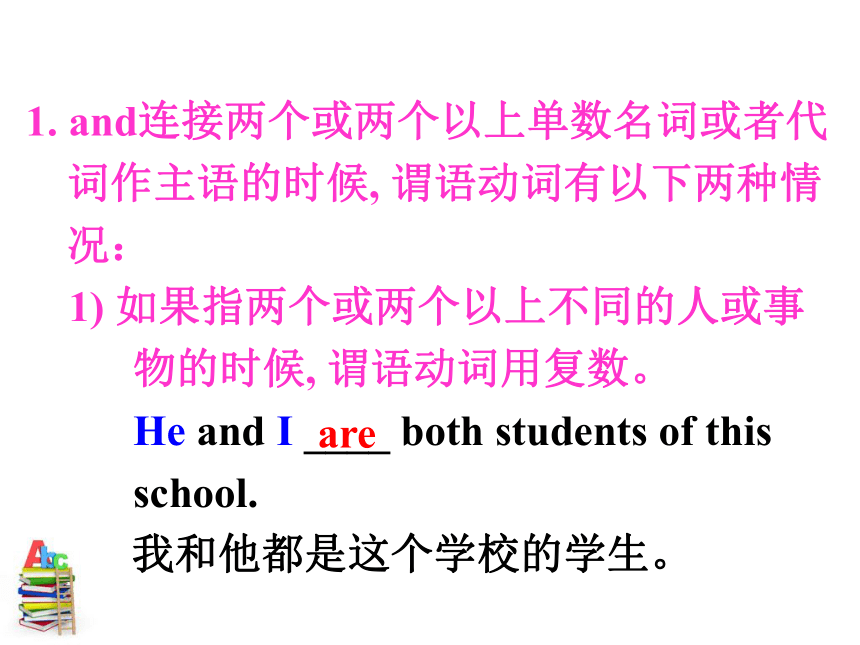
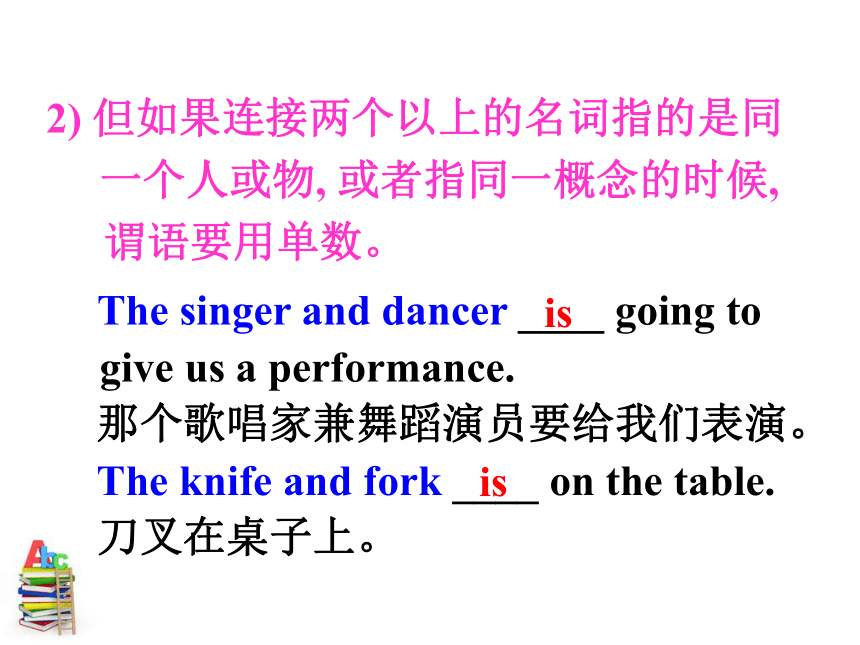
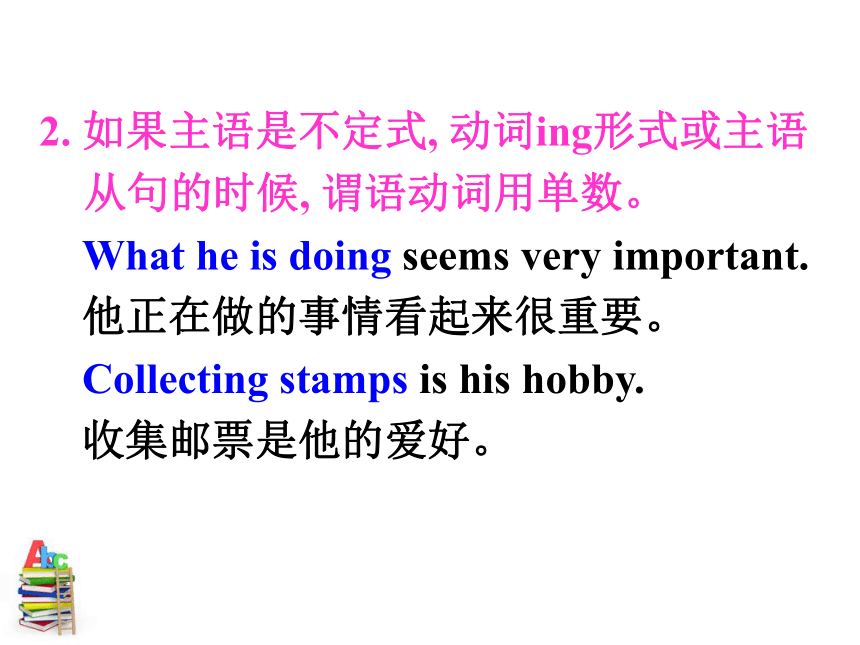
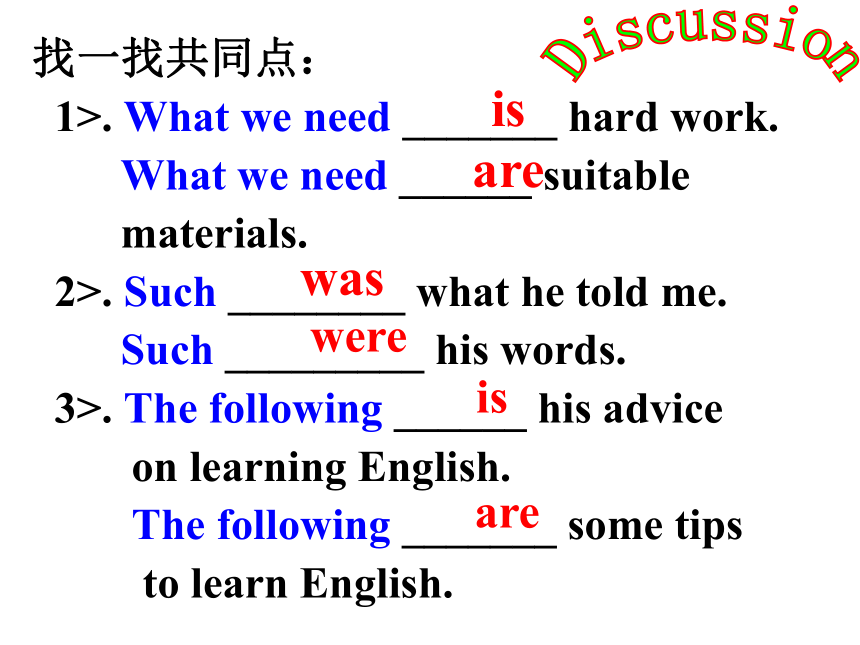

文档简介
课件50张PPT。主谓一致主谓一致Subject-verb AgreementThe boy _____ diving.They _____ diving.Both Jack and Tim _____ diving.All of them _____ diving.Neither Jack nor Tim _____ walking.isareareisareFinish the following exercises:主谓一致是指主语和谓语要保持人称和数上的一致,主语的“人称”和“数”决定谓语动词的变化。
但是如果主语不是单一的,或主语名词的数比较特殊时,其主谓一致一般要根据语法一致\意义一致\就近原则.Bob _____ a worker.isMike and Bob _____ workers.areBoth Mike and Bob _______
workers.areNeither Mike nor Bob _______
a teacher.isNeither of them _______
(know) how to teach English. knows/knowAll of them ______ workers.None of them ___________
(know) how to teach English.are knows/know主谓一致主要有以下几种情况: 语法一致是指句子的主语和谓语在语法形式上一致,即谓语动词的单复数形式依主语的单复数形式而定。主语为单数时谓语动词用单数,主语为复数时谓语动词也用复数。语法一致原则1. and连接两个或两个以上单数名词或者代词作主语的时候, 谓语动词有以下两种情况:
1) 如果指两个或两个以上不同的人或事
物的时候, 谓语动词用复数。
He and I ____ both students of this
school. 我和他都是这个学校的学生。 are The singer and dancer ____ going to give us a performance.
那个歌唱家兼舞蹈演员要给我们表演。
The knife and fork ____ on the table.
刀叉在桌子上。 isis2) 但如果连接两个以上的名词指的是同
一个人或物, 或者指同一概念的时候, 谓语要用单数。 2. 如果主语是不定式, 动词ing形式或主语从句的时候, 谓语动词用单数。
What he is doing seems very important.
他正在做的事情看起来很重要。
Collecting stamps is his hobby.
收集邮票是他的爱好。找一找共同点:
1>. What we need _______ hard work.
What we need ______ suitable
materials.
2>. Such ________ what he told me.
Such _________ his words.
3>. The following ______ his advice
on learning English.
The following _______ some tips
to learn English. is are waswere is areDiscussion动名词、不定式或从句作主语时,谓语用
但what引导的主语从句视后面的表语而定。
What we need time. ( be)
What we need books. ( be)
is are单数视其在句中的意义,谓语动词可用作单数或复数。 3. 定语从句的关系代词who, which, that
在从句中作主语时,定语从句中的谓语动词要与先行词的人称和数保持一致。
Those who enjoy singing may join us.
Tom, who is your friend, should help
you.
He is one of the students who ___(be) praised by the teacher.
He is the only one of the students who ___(be) praised by the teacher.
are is 4. 如果句子中有这些连接词(with, along with, together with, as well as, besides, like, without, except, but, including)和主语连用, 谓语动词的数随主语的变化而变化。
The teacher, together with his students, ____ planting trees in the street.
老师和他的学生们正在街上植树。 is 就近一致是指谓语动词的人称和数与它
最邻近的名词或代词保持一致。
either ... or; neither ... nor; not only ... but also, whether...or 在句子中连接主语的时候或者在there be句型中, 谓语动词要和就近的主语保持一致。就近原则 e.g. Neither you nor I am wrong.
There is a cup of tea and some
apples on the table.
Not only the students but also the
teacher wishes for a holiday. 概念一致原则是指谓语动词和主语一致不是取决于主语的语法形式, 而是其实际意义。有的主语名词在形式上是单数, 但在意义上却是复数;有的主语名词在形式上是复数, 但在意义上却是单数。意义一致原则 1. 不定代词all, more, some, any, none作主语, 谓语动词视情况而定。All of the apples ____ rotten.
所有的苹果都烂了。
All of the apple ____ rotten.
整个苹果都烂了。
不定代词all, more, some, any, none作主语, 谓语动词视情况而定。 are isNone of the money _____ left.
没有剩下一点钱。
None of the students _____ there.
没有学生在那里。 is is/are2. the rest of, half of, part of, majority of, percent of, one third of等在句子中加名词作主语的时候, 谓语动词与of后面的名词保持一致。Half of the students _____ finished their
composition.
一半的学生已经完成了他们的作文。
Half of the apple ____ bad.
一半的苹果坏了。
About 60 percent of the students in our
school ____ boys.
我们学校, 大约百分之六十的学生是男
生。haveisare3. 集体名词作主语, 动词可以用单数, 也可以用复数。由句子的意思决定。强调整体谓语动词用单数;指全体人员时, 动词则用复数。常见的集体名词有public, family, class, crowd, population, team, group等。His family ____ going out.
他们全家要外出。
His family ____ all music lovers.
他们全家人都是音乐爱好者。is are 4. 某些名词如people, police, cattle等, 形式上是单数, 但意义上是复数, 谓语动词应用复数。people指“民族”时是例外。
The police ____ searching for a thief.
The cattle ____ eating grass on the hill.areare5. 复合不定代词作主语, 谓语动词要用单数,如someone, somebody, something, anybody, anyone, anything, everybody, everyone, everything, nobody, no one, nothing等。
Someone ____ asking for you.
有人找你。
Nothing ____ found in the room.
在屋子里什么也没找到。isis6. 某些名词如clothes, trousers, shoes, glasses等, 通常只用其复数形式, 但当它们被a pair of 修饰时, 谓语动词用单数。
The pair of shoes ____ worn out.
这双鞋破了。
The shoes ____worn out.
鞋子破了。isare7. 某些名词以s结尾如maths, politics, physics, news, plastics等, 谓语动词应用单数。
Physics is a very interesting subject.
物理是一门很有趣的学科。
the Olympic Games谓语常用复数The Olympic Games held once every four years. (be)
are8. every... and every ...; each ... and each ...; no ... and no ...; many a …and many a 在以上短 语中and连接的单数名词, 整个短语 在句中作主语时, 谓语动词常使用单数。
Each man and each woman is asked
to attend. Every boy and every girl in the class is diligent. 班级中的每个男孩女孩都很用功。
No sound and no voice is heard. 听不到任何声音。9. 以a number of作主语时, 谓语动词用复数; 以the number of 作主语时, 谓语动词用单数。
A number of new books ____ on the
desk.
The number of students in you class ____ 50.areis10. 有些名词的单数和复数形式一样, 作主语的时候, 其谓语动词由上下文决定, 这一类名词有: means, works, deer, fish, sheep, Chinese, Japanese等。
Not every means ____ useful.
不是每种方法都好使。
Not all means ____ useful.
不是所有的方法都好使。 isare11. many a, more than one, one and a half与单数名词组成的短语, 谓语用单数。
Many a boy has seen it.
许多孩子都看到了。
12. 书刊名、时间、距离、价格、度量衡等的复数名词作主语时, 谓语动词常用单数。
Thirty years is not a long time.
Roots is a famous American novel.1. this kind of book = a book of this kind (这种书) , 其谓语用单数; 短语this kind of men = men of this kind = these kind of men (口语) (这一类人), 但this kind of men的谓语用单数, men of this kind和these kind of men的谓语用复数, all kinds of后跟复数名词, 谓语用复数形式。如:注意: This kind of men___ dangerous.
Men of this kind dangerous.
2. 在主谓倒装的句子中, 谓语动词的数应与其后的主语一致。如:
Between the two windows (hang) a picture. is are hangs 3. “分数或百分数+名词”构成的短语以及由“a lot of, lots of, plenty of, a large quantity of, a heap of, heaps of, half of + 名词”构成的短语作主语时, 其谓语动词要与短语中of后面的名词的数保持一致, 这是因为短语中后面的名词是中心词, 而短语中前面的量词是修饰语。如:Lots of damage was caused by fire.
About three-fourths of the earth’s surface is covered with water.
Three-fifths of the workers here are women.注意:
a (large) quantity of修饰可数或不可数名词, 其短语作主语时, 谓语动词用单数。
e.g. A large quantity of people is
needed here.quantities of 修饰可数或不可数名词, 其短语作主语时, 谓语动词一般用复数。如:
Quantities of food (nuts) were on the table.
短语in quantity, in large quantities 意为 “大量”; in small quantities 意为“少量”。 4. a great deal of, a large amount of, 修饰不可数名词, 其短语作主语时, 谓语动词通常用单数; large amounts of修饰不可数名词, 其短语作主语时, 谓语动词通常用复数。如:A large amount of (A great deal of) damage was done in a very short time.
Large amounts of money were spent on the bridge.5. 表示数量的one and a half后, 名词要用复数形式, 但是其短语作主语时, 谓语动词用单数形式。如:
One and a half bananas is left on the table.6. 如果主语由“the + 形容词(或过去分词)”结构担任时, 谓语通常用复数, 这类词有: the brave, the poor, the rich, the blind, the young, the old, the sick, the dead, the deaf and dub, the oppressed, the injured, the wounded, the unemployed 等; 但也有少数的过去分词与定冠词连用时指个别,则用单数。如:The blind study in special school.
The departed (死者) was a well-known engineer.
这类形容词或分词如果要表示个体时, 就要与名词man, person或表示人的单数连用。如:
an old man, a rich person, the (a) wounded soldier.Help Xiaoshun choose the correct verb form in this letter.
Dear Xiaoyu,
I think everyone _____ (is/ are) settled in London, although neither the weather nor the food _____ (is/ are) good. Either rain or snow fell ever day this week but everybody ____ (has/ have) tried to ignore it.isishasMy friends and my mother ____ (has/ have) visited almost all the museums in London. None of them ____________ (carry/ carries) an umbrella but nobody _____ (has/ have) let that affect their activities. We are enjoying ourselves so much that I wonder if anybody _____ (want/ wants) to come home. This grouphavecarry/ carrieshaswantsof tourists ____ (love/ loves) the culture and ____ (is/ are) happy in England and would like to visit London every summer.loveareAll we need______ a small piece of land where we can plant various kinds of fruit trees throughout the growing seasons of the year .
A. are B. was C. is D. were高考链接2. The famous musician, as well as his
students, ______ to perform at the
opening ceremony of the 2012 Taipei
Flower Expo.
A. were invited
B. was invited
C. have been invited
D. has been invited3. Generally, students’ inner motivation with high expectations from others ________ essential to their development.
A. is B. are C. was D. were
但是如果主语不是单一的,或主语名词的数比较特殊时,其主谓一致一般要根据语法一致\意义一致\就近原则.Bob _____ a worker.isMike and Bob _____ workers.areBoth Mike and Bob _______
workers.areNeither Mike nor Bob _______
a teacher.isNeither of them _______
(know) how to teach English. knows/knowAll of them ______ workers.None of them ___________
(know) how to teach English.are knows/know主谓一致主要有以下几种情况: 语法一致是指句子的主语和谓语在语法形式上一致,即谓语动词的单复数形式依主语的单复数形式而定。主语为单数时谓语动词用单数,主语为复数时谓语动词也用复数。语法一致原则1. and连接两个或两个以上单数名词或者代词作主语的时候, 谓语动词有以下两种情况:
1) 如果指两个或两个以上不同的人或事
物的时候, 谓语动词用复数。
He and I ____ both students of this
school. 我和他都是这个学校的学生。 are The singer and dancer ____ going to give us a performance.
那个歌唱家兼舞蹈演员要给我们表演。
The knife and fork ____ on the table.
刀叉在桌子上。 isis2) 但如果连接两个以上的名词指的是同
一个人或物, 或者指同一概念的时候, 谓语要用单数。 2. 如果主语是不定式, 动词ing形式或主语从句的时候, 谓语动词用单数。
What he is doing seems very important.
他正在做的事情看起来很重要。
Collecting stamps is his hobby.
收集邮票是他的爱好。找一找共同点:
1>. What we need _______ hard work.
What we need ______ suitable
materials.
2>. Such ________ what he told me.
Such _________ his words.
3>. The following ______ his advice
on learning English.
The following _______ some tips
to learn English. is are waswere is areDiscussion动名词、不定式或从句作主语时,谓语用
但what引导的主语从句视后面的表语而定。
What we need time. ( be)
What we need books. ( be)
is are单数视其在句中的意义,谓语动词可用作单数或复数。 3. 定语从句的关系代词who, which, that
在从句中作主语时,定语从句中的谓语动词要与先行词的人称和数保持一致。
Those who enjoy singing may join us.
Tom, who is your friend, should help
you.
He is one of the students who ___(be) praised by the teacher.
He is the only one of the students who ___(be) praised by the teacher.
are is 4. 如果句子中有这些连接词(with, along with, together with, as well as, besides, like, without, except, but, including)和主语连用, 谓语动词的数随主语的变化而变化。
The teacher, together with his students, ____ planting trees in the street.
老师和他的学生们正在街上植树。 is 就近一致是指谓语动词的人称和数与它
最邻近的名词或代词保持一致。
either ... or; neither ... nor; not only ... but also, whether...or 在句子中连接主语的时候或者在there be句型中, 谓语动词要和就近的主语保持一致。就近原则 e.g. Neither you nor I am wrong.
There is a cup of tea and some
apples on the table.
Not only the students but also the
teacher wishes for a holiday. 概念一致原则是指谓语动词和主语一致不是取决于主语的语法形式, 而是其实际意义。有的主语名词在形式上是单数, 但在意义上却是复数;有的主语名词在形式上是复数, 但在意义上却是单数。意义一致原则 1. 不定代词all, more, some, any, none作主语, 谓语动词视情况而定。All of the apples ____ rotten.
所有的苹果都烂了。
All of the apple ____ rotten.
整个苹果都烂了。
不定代词all, more, some, any, none作主语, 谓语动词视情况而定。 are isNone of the money _____ left.
没有剩下一点钱。
None of the students _____ there.
没有学生在那里。 is is/are2. the rest of, half of, part of, majority of, percent of, one third of等在句子中加名词作主语的时候, 谓语动词与of后面的名词保持一致。Half of the students _____ finished their
composition.
一半的学生已经完成了他们的作文。
Half of the apple ____ bad.
一半的苹果坏了。
About 60 percent of the students in our
school ____ boys.
我们学校, 大约百分之六十的学生是男
生。haveisare3. 集体名词作主语, 动词可以用单数, 也可以用复数。由句子的意思决定。强调整体谓语动词用单数;指全体人员时, 动词则用复数。常见的集体名词有public, family, class, crowd, population, team, group等。His family ____ going out.
他们全家要外出。
His family ____ all music lovers.
他们全家人都是音乐爱好者。is are 4. 某些名词如people, police, cattle等, 形式上是单数, 但意义上是复数, 谓语动词应用复数。people指“民族”时是例外。
The police ____ searching for a thief.
The cattle ____ eating grass on the hill.areare5. 复合不定代词作主语, 谓语动词要用单数,如someone, somebody, something, anybody, anyone, anything, everybody, everyone, everything, nobody, no one, nothing等。
Someone ____ asking for you.
有人找你。
Nothing ____ found in the room.
在屋子里什么也没找到。isis6. 某些名词如clothes, trousers, shoes, glasses等, 通常只用其复数形式, 但当它们被a pair of 修饰时, 谓语动词用单数。
The pair of shoes ____ worn out.
这双鞋破了。
The shoes ____worn out.
鞋子破了。isare7. 某些名词以s结尾如maths, politics, physics, news, plastics等, 谓语动词应用单数。
Physics is a very interesting subject.
物理是一门很有趣的学科。
the Olympic Games谓语常用复数The Olympic Games held once every four years. (be)
are8. every... and every ...; each ... and each ...; no ... and no ...; many a …and many a 在以上短 语中and连接的单数名词, 整个短语 在句中作主语时, 谓语动词常使用单数。
Each man and each woman is asked
to attend. Every boy and every girl in the class is diligent. 班级中的每个男孩女孩都很用功。
No sound and no voice is heard. 听不到任何声音。9. 以a number of作主语时, 谓语动词用复数; 以the number of 作主语时, 谓语动词用单数。
A number of new books ____ on the
desk.
The number of students in you class ____ 50.areis10. 有些名词的单数和复数形式一样, 作主语的时候, 其谓语动词由上下文决定, 这一类名词有: means, works, deer, fish, sheep, Chinese, Japanese等。
Not every means ____ useful.
不是每种方法都好使。
Not all means ____ useful.
不是所有的方法都好使。 isare11. many a, more than one, one and a half与单数名词组成的短语, 谓语用单数。
Many a boy has seen it.
许多孩子都看到了。
12. 书刊名、时间、距离、价格、度量衡等的复数名词作主语时, 谓语动词常用单数。
Thirty years is not a long time.
Roots is a famous American novel.1. this kind of book = a book of this kind (这种书) , 其谓语用单数; 短语this kind of men = men of this kind = these kind of men (口语) (这一类人), 但this kind of men的谓语用单数, men of this kind和these kind of men的谓语用复数, all kinds of后跟复数名词, 谓语用复数形式。如:注意: This kind of men___ dangerous.
Men of this kind dangerous.
2. 在主谓倒装的句子中, 谓语动词的数应与其后的主语一致。如:
Between the two windows (hang) a picture. is are hangs 3. “分数或百分数+名词”构成的短语以及由“a lot of, lots of, plenty of, a large quantity of, a heap of, heaps of, half of + 名词”构成的短语作主语时, 其谓语动词要与短语中of后面的名词的数保持一致, 这是因为短语中后面的名词是中心词, 而短语中前面的量词是修饰语。如:Lots of damage was caused by fire.
About three-fourths of the earth’s surface is covered with water.
Three-fifths of the workers here are women.注意:
a (large) quantity of修饰可数或不可数名词, 其短语作主语时, 谓语动词用单数。
e.g. A large quantity of people is
needed here.quantities of 修饰可数或不可数名词, 其短语作主语时, 谓语动词一般用复数。如:
Quantities of food (nuts) were on the table.
短语in quantity, in large quantities 意为 “大量”; in small quantities 意为“少量”。 4. a great deal of, a large amount of, 修饰不可数名词, 其短语作主语时, 谓语动词通常用单数; large amounts of修饰不可数名词, 其短语作主语时, 谓语动词通常用复数。如:A large amount of (A great deal of) damage was done in a very short time.
Large amounts of money were spent on the bridge.5. 表示数量的one and a half后, 名词要用复数形式, 但是其短语作主语时, 谓语动词用单数形式。如:
One and a half bananas is left on the table.6. 如果主语由“the + 形容词(或过去分词)”结构担任时, 谓语通常用复数, 这类词有: the brave, the poor, the rich, the blind, the young, the old, the sick, the dead, the deaf and dub, the oppressed, the injured, the wounded, the unemployed 等; 但也有少数的过去分词与定冠词连用时指个别,则用单数。如:The blind study in special school.
The departed (死者) was a well-known engineer.
这类形容词或分词如果要表示个体时, 就要与名词man, person或表示人的单数连用。如:
an old man, a rich person, the (a) wounded soldier.Help Xiaoshun choose the correct verb form in this letter.
Dear Xiaoyu,
I think everyone _____ (is/ are) settled in London, although neither the weather nor the food _____ (is/ are) good. Either rain or snow fell ever day this week but everybody ____ (has/ have) tried to ignore it.isishasMy friends and my mother ____ (has/ have) visited almost all the museums in London. None of them ____________ (carry/ carries) an umbrella but nobody _____ (has/ have) let that affect their activities. We are enjoying ourselves so much that I wonder if anybody _____ (want/ wants) to come home. This grouphavecarry/ carrieshaswantsof tourists ____ (love/ loves) the culture and ____ (is/ are) happy in England and would like to visit London every summer.loveareAll we need______ a small piece of land where we can plant various kinds of fruit trees throughout the growing seasons of the year .
A. are B. was C. is D. were高考链接2. The famous musician, as well as his
students, ______ to perform at the
opening ceremony of the 2012 Taipei
Flower Expo.
A. were invited
B. was invited
C. have been invited
D. has been invited3. Generally, students’ inner motivation with high expectations from others ________ essential to their development.
A. is B. are C. was D. were
同课章节目录
- 名词
- 动词/动词短语
- 一般现在时及其被动式
- 一般过去时及其被动式
- 现在进行时及其被动式
- 过去进行时及其被动式
- 将来进行时及其被动式
- 现在完成时及其被动式
- 过去完成时及其被动式
- 一般将来时及其被动式
- 过去将来时及其被动式
- 现在完成进行时及其被动式
- 将来完成时及其被动式
- 副词
- 介词/介词短语
- 连词/连接词
- 数词/量词
- 冠词
- 形容词
- 非谓语动词
- 句型
- 简单句与并列句
- 复合句
- 主谓一致
- 倒装与省略
- 强调句
- 虚拟语气
- 插入语
- 固定句型
- 祈使句/感叹句
- 疑问句/反义疑问句
- 非限制性定语从句
- 句型转换
- 定语从句
- 表语从句
- 宾语从句
- 主语从句
- 动词时态与语态
- 虚拟语气与情态动词
- 主谓一致
- 独立主格结构、with的复合结构
- 情态动词
- 状语从句
- 定语从句
- 特殊句式
- 交际用语
- 代词/不定代词
- 名词性从句
- 同位语从句
- 表语从句
- 宾语从句
- 主语从句
- 直接引语和间接引语
- 构词法(word formation)
